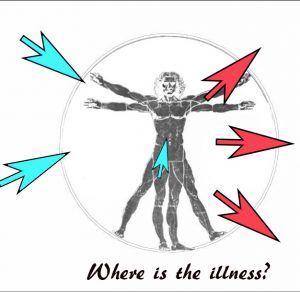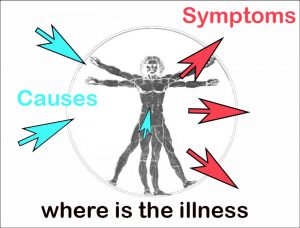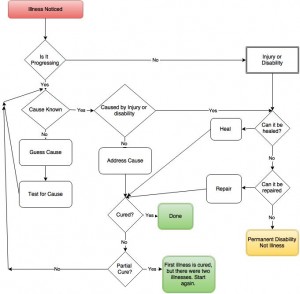 Medicine has a problem, and it’s getting worse, not better. The problem is disease. The more we study diseases, the more contributing factors we find. Cancer, the most extreme example, is caused by everything, and at the same time, prevented by everything – a statement supported by our best scientific research, but at the same time, it’s cured by nothing.
Medicine has a problem, and it’s getting worse, not better. The problem is disease. The more we study diseases, the more contributing factors we find. Cancer, the most extreme example, is caused by everything, and at the same time, prevented by everything – a statement supported by our best scientific research, but at the same time, it’s cured by nothing.
We no longer search for cures. Five recently published medical dictionaries do not contain the word ‘cure’. Ridiculous, but true. Medical reference books like MERCK, Lange’s, and Harrison’s do not define cure, avoid the word cure, or do not use the word cure consistently. Now that’s just silly. This leads to treatments that ‘do not cure’; to encouraging patients to learn to ‘live with their disease‘; to chronic disease. Ridiculous. But true. Gradually, more and more diseases are becoming incurable and chronic.
There is a path out of this dark forest. It’s almost trivial. We need to simplify.
An illness element has a single cause, and a single cure. Click To Tweet
Each illness element has a single cause.
Can this be true? Yes, it can. We can make it true, by definition. We can define an illness element as a part of any illness that has a single cause.
The difference between an illness and a case of disease is well defined in the field of medicine and understood by every doctor.
An illness is what the patient has, what the patient brings to the doctor. A case of disease is what the doctor diagnoses, treats, and sometimes – cures. They might be the same.. they might not be the same.
 An illness element is a concept, the intersection of a single cause, and a set of consequences and symptoms.
An illness element is a concept, the intersection of a single cause, and a set of consequences and symptoms.
Where is the illness? Every illness is invisible. We see the symptoms first. We can track the symptoms back to the cause, although in some cases this might be difficult – in some cases it is trivial.
When we identify the cause, and link it to the consequences, we have identified the illness. But the illness is not a thing, it is not something we can see or touch. We see the signs and symptoms. Sometimes we can touch the cause.
Causes are not trivial. It is possible to experience many causes, without symptoms, without illness. There are causes of healthiness as well as causes of illness. Sometimes, a cause of healthiness is excessive or overextended, or perhaps deficient or under-utilized, resulting in illness.
Every cause has a cause. Every cause of a cause has a cause. It sounds complicated, but remember, every illness element has a single cause, which might have a single cause, which might have a single cause – creating a long train or chain of causes.
In most cases, the doctor treats symptoms of disease. The illness is diagnosed, but only the disease is treated. In most cases, cures are not attempted. If you are diagnosed with hypertension, depression, arthritis – and more – symptoms will be treated with little attempt to identify, much less address any cause. There will be no attempt to cure. Cured is even defined for these diseases according to the bureaucracies of modern medicine. As a result, if one is cured, it’s not possible to recognize, much less to prove, the cure. Cancer researchers study cause to death, in statistical studies. But when you have a cancer diagnosis, cause is ignored – treatment proceeds directly against the symptoms, the cancer cells.
Many diseases once considered curable in most cases, like depression, are now considered treatable, but not curable. Many cures have been lost. Medicine, the practice of medicine and the science of medicine, is broken.
There is a simple way out. We need to move in the opposite direction, to search for causes, to search for cures.
Each illness element has a single cause. Successfully addressing cause cures.
Can this be true? We can make it true. We have many illnesses to use as models.
- Pneumonia can be caused by a bacterial infection, cured with an antibiotic which addresses the cause.
- Scurvy – is caused by a deficiency of Vitamin C, cured by a healthy diet, with sufficient Vitamin C.
- Carbon monoxide poisoning can be caused by an unhealthy work environment, cured by addressing the cause, by healthing the work environment.
In each example, curing the illness is simple. But, of course, there’s a challenge. Not every case of pneumonia is cured by an antibiotic. Not every case of scurvy is cured with Vitamin C. Not every case of carbon monoxide poisoning is cured by healthing the work environment. And even when they cure, those cures might not be the most effective. In each case of an illness, the cause and the causal chain can be a bit different, or very different.
To cure each case of an illness, we need to find the best cure cause. Scurvy might be caused by poverty, by addiction, by lack of dietary knowledge, by food likes and dislikes, even by living on a faulty diet prepared by someone else. Each cause is unique. In each case, the illness can only be cured by addressing a cure cause.
Every illness element has a single cause. But a disease – like scurvy – does not have a single cause. Only a specific case, a single illness element, has a single cause. As a result, each specific case, every illness element, has a single cure concept: address the cause. What if many different actions might cure an illness? An infection might be cured by healthy actions, or by an antibiotic, or by surgery. Which is the cure? The one that cures.
Each case of an illness is a single case with a single cause. The cure cause is identified when the illness is cured. When the illness has been cured – there are no more questions about “which cause“.
Every disease has many different cases, many different causes. In order to cure a disease – it must be mapped to one or more illness elements, and each must be cured to cure the disease.
But…. but… Don’t some illnesses have multiple causes, have many contributing factors? A disease can have multiple causes. A compound illness can have multiple causes. But by definition, an illness element has a single cause.
If we are to cure any illness, and know it has been cured, we must adopt the view that every illness has a single cause.
Let’s take a commonplace example – although this example might not be in any medical text. A patient is diagnosed with depression. What is the cause? Are there multiple causes? In the 1960s, depression was curable in most cases according to medical reference texts. Today, depression is incurable. What has changed? Our view.
Depression is actually a symptom, not an illness. But today’s medical practice, when it cannot cure, often gives up and names a disease after a symptom.
Depression symptoms have many causes.
- Depression symptoms can be caused by dietary deficiencies.
- Depression symptoms can be caused by dietary excesses.
- Depression symptoms can be caused by relationship problems, by loneliness, by financial strain, by physical abuse, by addiction, by chronic pain, and more.
What if someone is suffering from symptoms of depression as a result of several causes?
They are suffering from several illnesses. Each unique cause, and the resulting symptoms is an illness.
Unfortunately, many doctors are suffering from medical blinders. Doctors use the word depression to describe the symptoms. Doctors also use the word depression to describe the disease – the entire concept of the disease of depression. They also use the word depression to describe depression in a single patient. They also use the word depression to describe several different depressions, in a single patient. As a result, depression becomes complex, mysterious, and…. incurable.
When we take a different view, everything becomes clear – depression becomes curable.
The other view:
Each element of an illness has a single cause.
If a patient has four causes of depression, that patient has four illness elements, four depressions. Each is a single illness. Each has a single cure. To cure the patient’s depression disease, we must cure every element of depression, by addressing every cause. When any single illness cause is addressed – that illness element has been cured. But the patient might still have other depression causes, other depression illness elements, still have the disease depression. Once every depression is cured, the disease has been cured.
Health is a powerful curative. Sometimes, curing one or two of the depressions lift’s the patient’s spirits, and their health does the rest.
But if only symptoms are treated, it is much more difficult, sometimes impossible for the patient’s health to recover. The depression becomes incurable because no-one has attempted a cure.
 There is a simple (although not too simple) process to cure any illness. The steps are straightforward, although not trivial. Note: This post is about an ‘active illness’ with an active cause, not about a disability or injury illness.
There is a simple (although not too simple) process to cure any illness. The steps are straightforward, although not trivial. Note: This post is about an ‘active illness’ with an active cause, not about a disability or injury illness.
In theory, every illness can be cured, and many can be cured with this process.
To cure, using this process, requires two fundamental changes in our view of illness.
We must accept that:
- Every illness can be cured.
- Every illness has a single cause.
How can we be certain we have found the cause of an illness element? Only by curing it. How can we be certain we have cured the illness element? Only by knowing we have addressed the cause. Yes, it’s a circle. The cure is the cause, the cause is the cure. Escape is only possible – with a cure. Proof is never perfect, but a cure is a cure.
Once we adopt these rules, many cures can be found. But when we stop looking for cures, cures will not be found. We can only find cures when we search for them. If they happen by health, or by accident – we cannot see them unless we are looking for cures. Today, in today’s medical paradigm, when cures are caused by health, or by accident – we seldom notice them, they are ignored.
Cure ignorance abounds today’s medical theory and practice.
It’s time for a change in perspective.
When we understand, we can cure. When we do not understand, we cannot find cures, cannot see them when we encounter them.
to your health, to your cures,
tracy
Author: The Elements of Cure


